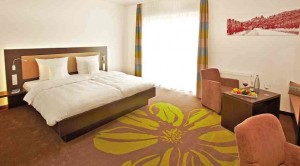
Having gone through my fair share of injections and all sorts of painful hospital procedures while growing up, I’ve never been afraid of needles. That is, until recently.
Can you blame me? Instead of one or two pinpricks, I’ve had to endure 10 injections given one after the other—five on each side of my butt—in the hope of finding temporary yet effective solutions to a number of health concerns.
Yes, I bit the bullet almost a month ago by agreeing to undergo live cell therapy in the hands of famed German doctor Robert Janson-Müller (see main story).
Within the comforts of my hotel room (one of 24 rooms at the fairly new Luitpold Hotel, which also doubles as Müller’s hospital and clinic), I was asked to lie flat on my stomach before Müller and his team of nurses went to work.
Having learned from experience that any medical procedure becomes more dreadful once you start staring at the needle, I never bothered to look and ask how many syringes one of the nurses had on her tray. Had I done so, I would probably have had second thoughts.
Each syringe supposedly contained sterile water combined with a cocktail of cells Müller extracted an hour or so earlier from a lamb embryo, and targeted specifically to address my needs. How painful were they?
For lack of a better description, it was like willing yourself to sample a spread of awful-tasting buffet dishes before your host. You had no choice but to swallow them.
Almost all of them were bearably painful, but certain injections were more painful than others. As Müller was halfway through the procedure, I simply bit my lip and held on to my pillow with each shot before thanking the heavens as soon as it was all over.
Organ-specific
Prior to the procedure, I spent the earlier part of the day consulting with Müller. Such one-on-one consultations would form the basis of his “organ-specific and tailor-made” treatments for me and a dozen other patients.
(Disclosure: Since each embryo normally yields enough cells for 15 people, publicist and former journalist Ivy Mendoza and I were able to avail ourselves of the treatment for free, at almost no extra cost to our hosts.)
While the rest of the patients, including a 63-year-old Filipino woman who attributed her speedy recovery from an emergency spinal operation to a previous treatment she received from Müller to manage her diabetes, rested and underwent “detoxification” and vitamin infusion the entire afternoon, the good doctor was busy several kilometers away preparing the necessary cell combinations to be injected in the evening.
A sheep farm in the nearby town of Neustadt has been providing Müller with pregnant Merino sheep for his needed embryos. After being carefully selected and quarantined from the rest of the herd, the sheep is slaughtered before its embryos are extracted and liquefied.
“We don’t save the mother sheep anymore because it makes no sense to keep her alive,” Müller explained. “I could do a Caesarean by closing her, but before you know it three weeks have passed and she’s now ready to be slaughtered for lamb chops.”
Over the years, Müller has been able to build a good relationship with the farm’s owners. In fact, the family has allowed him to build a sterile and state-of-the-art laboratory within the compound to work on his concoctions. He then drives back to the hotel in Edenkoben armed with individualized syringes ready to be injected.
Over in three minutes
My huge room may have looked like any other modern hotel room in the world, but I soon realized on day two of my four-day, three-night stay that it wasn’t.
Nurses armed with their own keys came and went to administer vitamins intravenously, check on my temperature and, minutes before the procedure, inject me with an anti-allergy shot.
It was almost surreal, especially when I emerged from the bathroom to find a team of barely recognizable masked men and women led by Müller wearing scrubs and staring back at me. This is it, I told myself.
It was a good thing they didn’t barge in while I was naked, as the place was for all intents and purposes not a hotel you could cocoon yourself in, but a hospital with postcard-pretty views minus that sickening antiseptic smell.
The actual procedure was over in less than three minutes. But not even Müller’s gentle voice continuously coaxing me to “think of your rejuvenation” was enough to soothe my frayed nerves and sore bottoms, as I was mildly trembling on and off for the next 20 minutes or so as I lay flat on my stomach.
My friends at the office could laugh about it now, but had I said a word while I was shaking involuntarily, I would have probably sounded, they teased, like the poor unborn lamb that went straight to heaven for my sake. Oh, no-oo-oo-oo!
I learned later on from Joey Santos, Müller’s business partner in the Philippines, that my reaction was more “psychological.” Each patient reacts differently during and immediately after the series of injections, he said.
When Santos first invited me several weeks earlier to fly to Germany to interview Müller, I was initially cool to the idea of trying the therapy myself. It wasn’t the number of injections that bothered me, but the likely side effects I could face later on.
What made me change my mind? The minute I learned that Ivy, a good friend of mine, was doing it in the hope of finding some relief from her nagging back problems. What have I got to lose?
Fortunately, I’ve never experienced any serious and prolonged aches and pains in my life. One of my major health issues is hidden from view and seemingly more benign.
Low blood count
Sometime in 2011, while I was hospitalized supposedly for dengue, my blood count dropped to alarmingly low levels. It was to be expected, as one of the most common manifestations of dengue is a dramatic drop in a person’s blood count, especially his platelets.
Less than a week after I was discharged, my attending physician required me to undergo another round of blood tests. The results gave her good reason to be concerned. Although my platelet count had barely managed to cross over to the safe side, my white blood count or WBC was still below average.
She immediately advised me to see a hematologist. As the blood specialist and I went through my earlier records, I discovered that my condition had already existed as early as 2008 (perhaps even earlier). I was so focused on my lipid profile that I (and so did my doctors then) failed to see other more telling aspects of my earlier blood tests.
Looking back now, I could only laugh about it because I really thought I only had a few months more to live. Well, to be technical about it, we’re all dying the minute we were born, aren’t we? Some just die ahead of others.
A spleen exam and two bone marrow biopsies later (I told you, I’m now a hardened veteran when it comes to needles), I’m still very much around and up and about despite my less-than-average WBC.
To this day, my hematologist still can’t figure out what exactly is wrong with me. If it’s any consolation, both biopsies done on me in 2012 and 2013 revealed that I’m so far cancer-free. And the best part is I don’t feel and look sick.
“It’s just your luck that your bone marrow was probably made in China and not in Japan,” my hematologist once kidded me.
No one-shot deal
During my morning-after consultation with Müller, I learned that the cocktail of sheep cells he mixed especially for me included, among others, liver cells (for optimum metabolism), spleen cells (to boost the immune system), skin cells (to help relieve me from my chronic eczema) and parts of the small intestines (again to help boost my immune and digestive systems).
For good measure, he added bits of umbilical cord (again for improved skin regeneration), heart and blood vessel cells, thymus (another immune booster) and, yes, bone marrow to help boost my low blood count.
Hopefully, I would start seeing and feeling the effects within one to four weeks, Müller said. But live cell therapy, he added, isn’t a one-shot deal, especially for people suffering from degenerative and irreversible diseases such as multiple sclerosis and Alzheimer’s, where the main goal is to keep them “on a plateau longer.” Follow-up visits every six months are thus necessary.
“Just listen inside yourself,” Müller said. “Usually, the more severe the patient’s health problems are, the more dramatic the results. You don’t have a severe health problem.”
Well, I will soon find out if my Chinese-made bone marrow has found its match in the good doctor’s German-made sheep cells.













































